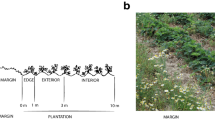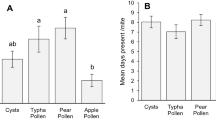Abstract
Predation by naturally occurring predatory arthropods was investigated to explain variations in population numbers of twospotted spider mite (Tetranychus urticae Koch) between first and second season strawberry crops.
Araneomorph spiders. European harvestman [Phalangium opilio (L.)], Tasmanian lacewing [Micromus tasmaniae (Walker)] and Pacific damsel bug [Nabis kinbergii Reuter] were the only predators found in high numbers. However, spiders and harvestment were more prevalent than lacewings and nabids.
Laboratory feedings trials indicated spiders build horizontal webs in the plants and prey predominantly on small flying insects that shelter in the crops. Similar feeding trials cofirmed the palatability of TSSM to spiders and harvestmen.
Immunological testing for proteins of TSSM, aphids, Collembola and leafrollers in the intestines of field collected European harvestman, spiders, Tasmanian lacewing and Pacific damsel bug confirmed European harvestman includes TSSM in its diet, but not in large enough quantities to exert a significant regulating pressure on TSSM populations. Lacewings and nabids include TSSM in their diets but only in very small quantities (2% and 1% respectively). Spiders do not take TSSM unless they drop or spin down onto the spider webbing.
The immunological testing also showed European harvestman to be a polyphagous and opportunistic feeder. Prey residues were detected more frequently in harvestmen intestines at times of prey abundance which indicated a seasonality to harvestmen diet.
Résumé
On a évalué la prédation par les arthropodes prédateurs qui se trouvent naturellement dans les fraisiers, pour expliquer les variations numériques des tétranyques observées dans les cultures entre la première et la deuxième année. Seuls les araignées araneomorphes, le faucheur européen, le neuroptèreMicromus tasmaniae etNabis kinbergii se trouvaient en grand nombre. Cependant les deux premiers étaient plus nombreux que les autres.
Les études de laboratoire ont indiqué que les araignées tissent leurs toiles horizontalement dans les plantes, et qu'elles piègent surtout les petits insectes volants qui s'abritent dans le feuillage. Un test de préférence alimentaire a confirmé que le tétranyque est une nourriture acceptable pour les araignées et les faucheurs.
Les études immunologiques pour rechercher les protéines des proies: tétranyques, pucerons, Collembola et larves de tordeuses, dans le ventre des prédateurs piégés sur le terrain ont montré que les faucheurs ne consomment pas assez deT. urticae pour réduire d'une façon significative les populations de tétranyques. Le tétranyque représente seulement 2% de la nourriture deM. tasmaniae et 1 % de celle deNabis kinbergii. Les araignées ne prennent pas les tétranyques à moins qu'ils ne tombent dans la toile.
Ces études ont montré aussi que les faucheurs européens sont des prédateurs polyphages et opportunistes. Quand la proie est abondante on retrouve plus de débris de celle-ci dans leur tube digestif ce qui suggère une alimentation saisonnière de la part du prédateur.
Similar content being viewed by others
References
Adams, J. — 1984. The habitat and ecology of woodland harvestmen (Opiliones) in England. —Oikos, 42, 361–370.
Ashby, J. W. — 1974. A study of arthropod predation ofPieris rapae L. using serological and exclusion techniques. —Appl. Ecol., 11, 419–426.
Butcher, M. R. — 1986. Aspects of the ecology of a strawberry crop with special reference to twospotted spider mite [Tetranychidae: Acari]. —Ph. D. thesis, Univ. of Canterbury, New Zealand.
Butcher, M. R., Penman, D. R. & Scott, R. R. — 1987a: Population dynamics of twospotted spider mite in multiple year crops of Canterbury strawberries. —New Zealand J. Zoology, 14, (in press).
Butcher, M. R., Penman, D. R. & Scott, R. R. — 1987b. A binomial sequentially sampled decision plan for twospotted spider mite on Canterbury strawberries. —New Zealand J. Agric. Res., 15, (in press).
Chant, D. A. — 1956a. Predacious spider mites in orchards in south eastern England, —J. Hort. Sci., 31, 35–46.
Chant, D. A. — 1956b. Predacious spiders and mites on fruit trees. —Ann. Rep. East Malling Res. Stat., Kent. 1956, 175–178.
Dempster, J. P. — 1967. The control ofPieris rapae with DDT. The natural mortality of the young stages ofPieris. —J. Appl. Ecol., 4, 485–500.
Dondale, C. D. — 1956. Annotated lists of spiders (Araneae) from apple trees in Nova Scotia. —Can. Entomol., 88, 697–700.
Dondale, C. D. — 1958. Notes on the population densities of spiders (Araneae) in Nova Scotia apple orchards. —Can. Entomol., 90, 111–113.
Dondale, C. D. — 1966. The spider fauna (Araneida) of deciduous orchards in the Australian Capital Territory. —Aust. J. Zool., 14, 1157–1192.
Dondale, C. D., Parent, B. &Pitre, D. — 1979. A six year study of spiders (Araneae) in a Quebec apple orchard. —Can. Entomol., 111, 377–399.
Forster, R. R. — 1962. A key to the New Zealand harvestmen, part ITuatara, 10, 129–137.
Forster, R. R. — 1963. A key to the New Zealand harvestmen, part IITuatara, 11, 28–40.
Hukusima, S. — 1961. Studies on the insects association in crop fields. XXI. Notes on spiders in apple orchards. —Jap. J. App. Entomol. Zool., 5, 270–272.
Leathwick, D. — 1982. A comparative evaluation of lucerne aphid predators. —B. Sc. (Hons) diss.Univ. of Canterbury, New Zealand, 41 pp.
Legner, E. F. &Oatman, E. R. — 1964. Spiders on apple in Wisconsin and their abundance in a natural and two artificial environments. —Can. Entomol., 96, 1202–1207.
Mansour, F., Rosen, D., Shulov, A. &Plaut, H. — 1980 Evaluation of spiders as biological control agents ofSpodoptera littoralis larvae on apple in Israel. —Acta Oecologica/Oecol. Applic., 1, 225–232.
McCaffrey, J. P. &Horsburgh, R. L. — 1980 The spider fauna of apple trees in central Virginia. —Environ. Entomol., 9, 247–252.
McMurtry, J. A. &Johnson, A. G. — 1966. An ecological study of the spider miteOligonychus punicae (Hirst) and its natural enemies. —Hilgardia, 37, 363–402.
Phillipson, J. — 1960. A contribution to the feeding biology ofMitopus miro (F) (Phalangida). —J. Anim. Ecol., 29, 35–43.
Pickavance, J. R. — 1970. A new approach to the immunological analysis of invertebrate diets. —J. Anim. Ecol., 39, 715–724.
Putman, W. L. — 1967. Prevalence of spiders and their importance as predators in Ontario peach orchards. —Can. Entomol., 99, 160–170.
Putman, W. L. &Herne, D. C. — 1966. The role of predators and other biotic factors in regulating the population density of phytophagous mites in Ontario peach orchards. —Can. Entomol., 98, 808–820.
Rothschild, G. H. L. — 1966. A study of a natural population ofConomelus anceps (Germar) [Homoptera: Delphacidae] including observations on predation using the precipitin test.J. Anim. Ecol., 35, 413–434.
Sankey, J. H. P. — 1949. Observations on food, enemies and parasites of the British harvestspider [Arachnida: Opilionies]. —Entomol. Month. Mag., 85, 246–247.
Specht, H. B. &Dondale, C. D. — 1960. Spider populations in New Jersey apple orchards. —J. Econ. Entomol., 53, 810–814.
Snow, K. R. — 1970. The arachnids: an introduction. —Routledge & Kegan Paul Ltd, London, 84 pp.
Todd, V. — 1950. The prey of harvestmen [Arachnida: Opiliones]. —Entomol. Month. Mag., 86, 252–254.
Tung, A. S. — 1983. Production of large amounts of antibodies, non specific immunoglobulins and other serum proteins in ascitic fluids of individual mice and Guinea pigs. —Meth. Enzymol., 93, 12–23.
Tung, A. S., Ju, S. T., Sato, S. &Nisonoff, A. — 1976. Production of large amounts of antibodies in individual mice. —J. Immun., 116, 676–681.
Author information
Authors and Affiliations
Rights and permissions
About this article
Cite this article
Butcher, M.R., Penman, D.R. & Scott, R.R. Field predation of twospotted spider mite in a New Zealand strawberry crop. Entomophaga 33, 173–183 (1988). https://doi.org/10.1007/BF02372652
Received:
Accepted:
Issue Date:
DOI: https://doi.org/10.1007/BF02372652




